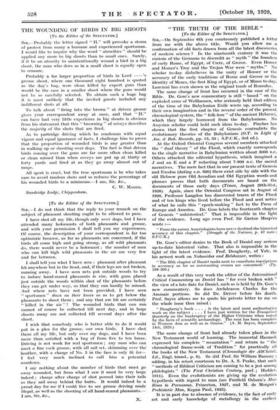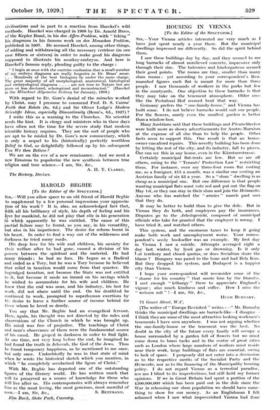" THE TRUTH OF THE BIBLE "
[To the Editor of the SPECTATOR.] Sin,—On September 6th you courteously published a letter from me with the above title. Would you allow me a confirmation of old facts drawn from all the latest discoVeries of modern science ? In the nineteenth century it was the custom of the Germans to discredit as " Myth " the founders of early Rome, of Egypt, of Crete, of Greece. Even Homer and Honier's Troy and the Trojan War were " myths." No scholar to-day disbelieVes in the unity of Homer or the accuracy of the early traditions of Rome and Greece or the identity of Menes, the first King of Egypt, or of Minos to-day. Lanciani has even "shown its the original tomb of Romulus.
The same change of frcint has occurredin the case of the Bible. Dr. Gore's new commentary is still " based " on the exploded error of Wellhausen, who seriously held that editors of the time of the Babylonian Exile wrote up, according to their own imagination and in the reverse order of the present chronological system, the " folk-lore " of the ancient Hebrewi; which they largely borrowed from the Babylonians. No Assyrian scholar could hold such ideas to-day. Pinches has shown that the first chapter of Genesis contradicts the evolutionary theories of the Babylonians (0.T. in Light of Ass. & Bab. Records, pp. 13, 33 ; S.P.C.K., 3rd ed.).
At the OxfOrd Oriental Congress several members attacked the " dual theory " of the Flood, which exactly corresponds to the single narrative in Babylonian written about 3000 B.C. Others attacked the editorial hypothesis, which imagined a J and an E and a P redacting about 7-800 B.C. the sacred narratives. The mere fact that in our present texts of Genesis and Exodus (dating A.D. 920) there exist side by side. with the old Hebrew pure Old Accadian and Old Egyptian words and phrases proves that both documents are based on the documents of those early days (Times, August 28th-31st; 1928). Again, since the Oriental Congress sat in August of 1928, Professor Langdon has discovered traces of the Flood and of ten kings who lived before the Flood and sent notice of what he calls this " epoch-making " fact to the Press of Europe and America. Dr. Gore labels the fourteenth chapter of Genesis " unhistorical." That is impossible in the light of the evidence. Long ago even Prof. Sir Gaston Maspero wrote " From the outset Assyriologists have never doubted the historical accuracy of this chapter." (Struggle of the Nations, p. 47 note : S.P.C.K.) Dr. Gore's editor denies to the Book of Daniel any serious up-to-date historical value. That also is impossible in the light of the latest evidence. Prof. Dougherty, of Yale, in his newest work on Nabonidus and Belshazzar, writes :
" The fifth chapter of Daniel ranks next to cuneiform inscriptions in accuracy as far as outstanding events aro concerned." (Pp. 199-200.)
As a result of this very work the editor of the International Critical Commentary on Daniel has `,` for ever broken . with " the view of a late date for Daniel, such as is held by Dr. Gore's new commentary. So does Archdeacon Charles for the Aramaic portions. So did Dr. Driver before his death. Prof. Sayre allows me to quote his private letter to in on the whole issue thus raised : " Dougherty's book . . . . is the latest and most authoritative work on the subject . . . . I have just written for the Evangelical Quarterly on the bankruptcy of the Higher Criticism when tested by the facts of scientific archaeology. The rout has been complete in Western Asia as well as in Greece." (A. H. Sayce, September 14th, 1929.)
The same change of front had already taken place in the
New Testament world of learning. The _immortal Harnack expressed his complete_ " recantation " and return to " the chronological frame-work of Tradition" for , practically all the books of the New Testament (Chronologie der AltChristl. Lit., Engl. transl., p. 9). So did Prof. Sir William Ramsay ; adding, in his retort courteous to:Dr, A. S. Peake, that such " methods of Biblical Criticism are coming to be.a jest among philologists " (The First Christian Century, pref. ; Hodder, 1911). Even the evolutionists are giving up the evolution hypothesis with regard to man (see Fairfield tt .0sborn's Man es to Parnassus, Princeton, 1927, and M. MMgan's Prehistoric Man, Kegan Paul, 1928).
It is in part due to absence of evidence, to_ the fact of early art and early knowledge of metallurgy in the earliest
civilisations and in part to a; reaction from Haeckel's wild methods. Haeekel was charged in 1908 by Dr. Arnold Brass, of the Kepler Blind, in his dai 'Wen-Problem, with " faking " bis diagrams in his famous work on dos Menschen Problem, published in 1907. He accused Haeckel, among other things, of adding and withdrawing all the necessary vertebrae (in one case fifteen or sixteen) in order to make good his diagrams supposed to illustrate his monkey-embryos. And here is Hawkers famous reply, pleading guilty to the charge : " I begin at once with the contrite confession that a small number of my embryo diagrams are really forgeries in Dr. Brass' sense.
. . Hundreds of the best biologists lie under the same charge. The great majority of- all morphological, anatomical, histological and embryological diagrams . . . . are not true to Nature but are more or less doctored, schematized and reconstructed." (Haeckel in the Miinehner Allgemeine Zeitung for January, 1909.) With regard to Dr. Gore's denial of the miracles worked by Christ, may I presume to commend Prof. D. S. Cairns' Faith that Rebels (8s. 6d.) and Sir Oliver Lodge's Modern Scientific Ideas, especially Discontinuity (Benn's, 8d., 1927) ?
I write this as a warning to the Churches. No scientist needs the hint. It is clergy and ministers who in these days have often not the time for the severe study that modern scientific history requires. They are the sort of people who are apt to be misled by Dr. Gore's new commentary, which is only a sequel to his (historically) perfectly worthless Belief in God, so delightfully followed up by his subsequent Can We then Believe ?
We are on the eve of a new renaissance. And we need a new Erasmus to popularize the new synthesis between true religion and true science.—I am, Sir, &c., A. H. T. CLARKE.
The Rectory, Devizes.























































 Previous page
Previous page